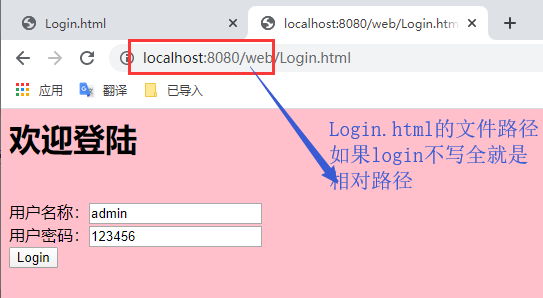获取请求参数值
1)HttpServletRequest
① 该接口是ServletRequest接口的子接口,封装了HTTP请求的相关信息,由Servlet容器创建其实现类对象并传入service(ServletRequest req, ServletResponse res)方法中。以下我们所说的HttpServletRequest对象指的是容器提供的HttpServletRequest实现类对象。
② HttpServletRequest对象的主要功能有
获取请求参数
在请求域中绑定数据
将请求转发给另外一个URL地址 [转发]
响应结果
1)HttpServletResponse
① 该接口是ServletResponse接口的子接口,封装了HTTP响应的相关信息,由Servlet容器创建其实现类对象并传入service(ServletRequest req, ServletResponse res)方法中。以下我们所说的HttpServletResponse对象指的是容器提供的HttpServletResponse实现类对象
② 主要功能
使用PrintWriter对象向浏览器输出数据
实现请求的重定向[重定向]
<body bgcolor="pink"> <h1>欢迎登录</h1> <!-- action: 请求的地址 http://http://localhost:8080/web/login 和从浏览器网址端输入效果一样,向服务器发送请求。可以是相对路径,所以可以只写login,对应web.xml文件pattern method: 请求的方式 GET :将请求数据拼接到请求地址中, 直接暴露出来. 3http://localhost:8888/web01/login?username=Admin&password=123456 POST :将请求数据存到请求体中提交,不会直接暴露出来。 --> <form action="login" method="post"> 用户名称:<input type="text" name="username"/> <br/> 用户密码 :<input type="password" name="password"/> <br/> <input type="submit" value="Login"/> </form> </body>

package com.web.servlet; import java.io.IOException; import java.io.PrintWriter; import javax.servlet.ServletException; import javax.servlet.http.HttpServlet; import javax.servlet.http.HttpServletRequest; import javax.servlet.http.HttpServletResponse; public class LoginServlet extends HttpServlet { /* //根据具体的请求方式来调用doGet 或者 doPost @Override protected void service(HttpServletRequest arg0, HttpServletResponse arg1) throws ServletException, IOException { // TODO Auto-generated method stub super.service(arg0, arg1); } */ @Override protected void doGet(HttpServletRequest req, HttpServletResponse resp) throws ServletException, IOException { doPost(req, resp); } @Override protected void doPost(HttpServletRequest req, HttpServletResponse resp) throws ServletException, IOException { //System.out.print("qingqiu"); req.setCharacterEncoding("utf-8"); //获取用户名 String username = req.getParameter("username"); //获取密码 String password = req.getParameter("password"); System.out.println(username + " , " + password ); resp.setContentType("text/html;charset=utf-8"); PrintWriter out = resp.getWriter(); if("Admin".equals(username)&&"123456".equals(password)) out.println("<h1><font color='green'>Login Success! 登录成功<h1>"); else { out.println("<h1><font color='green'>Login Fail! 登录失败<h1>"); } } }